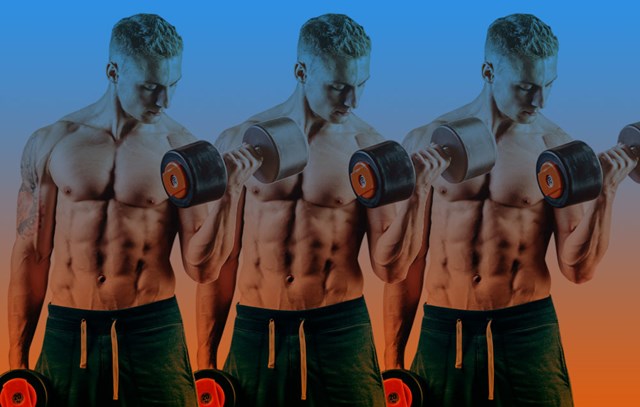
Guns, bad boys, weapons of mass destruction. There are plenty of nicknames for your biceps – and plenty of ways to work them, too.
So if your only strategy is do 3 sets of 10 of the classic curl, you’re missing out. The following 5 expert-approved techniques will help your biceps reach their peak potential.
Cheat Your Form
Strict form may be holding you back.
A study in the Eupropean Journal of Applied Physiology found that you don’t always have to do an exercise the way it’s intended to maximise your results.
Using a bit of momentum during the lateral raise, for example, increases the torque of your shoulder joint, helping you raise a heavier weight to the point at which your deltoids take over, according to the researchers.
“You can achieve a similar effect with biceps curls,” says sports biomechanist Bret Contreras.
The key is to keep the body English to a minimum. Not enough or too much inertia is inefficient, he says. You’ll want to use just enough momentum to help you propel the bigger weights up to your chest. The inertia should come from your hips, not your lower back. Choose a load that’s about 10 per cent heavier than you would normally lift.
Curl on an Incline
The front of your upper arm owes its bulge to your biceps brachii, which is composed of two separate sections: the long head and the short head.
In order to maximally activate your biceps—or create the biggest muscle contractions possible—you must stretch the heads at the shoulder joint and flex them at the elbow joint, says strength and conditioning specialist Dr Brad Schoenfeld. And the more you stretch them, the greater their capacity to flex or shorten.
By positioning your body on an incline while performing a dumbbell curl, your elbows hang behind your torso. This position stretches the heads across your shoulder joints, allowing the muscles to generate more force as you curl, he says.
Set an adjustable bench to a 45-degree incline and lie face-up. Grab a pair of dumbbells, and let them hang at arms length directly below your shoulders. Keeping your upper arms in the same position, curl the weights up.
Switch Up Your Grip
Underneath your biceps brachii is a muscle called the brachialis. Even though it’s located deep in the upper arm, it can still play an indirect role in the appearance of your biceps, says Schoenfeld.
“As your brachialis grows bigger, it expands and pushes out on your biceps brachii,” he says. So the larger your brachialis, the larger your biceps look.
The best way to hit your brachialis: reverse curls. Pronating your arms—or using an overhand grip—during a curl shortens the biceps brachii so they’re unable to carry out as much force.
When this happens, your brachialis has to take over and perform the majority of the work, explains Schoenfeld. Perform at least 5 reps to start.
Hit Pause
Ever notice how big gymnasts’ biceps are? They can thank the hours they spend holding difficult positions on the Olympic rings for their pumped up guns.
“The biceps respond well to high-tension, isometric contractions,” says physiologist Chad Waterbury.
When you pause or hold a weight so the length of your biceps don’t change, you target your type IIb muscle fibers, which are the ones with the most growth potential, he explains. Actively squeezing the muscle during an isometric contraction will also increase your gains.
Try this technique with an inverted row using what Waterbury calls a “5-3 iso-squeeze.” Using an underhand, wide grip, grab a bar that’s been secured about waist height. Hang with your arms completely straight and heels touching the floor. Your body should form a straight line from your ankles to your head. Pull your shoulder blades back, and continue to pull with your arms to lift your chest to the bar. Hold this position for 5 seconds while squeezing your biceps tightly.
“You should squeeze the muscles like you’re trying to make them cramp,” says Waterbury. Then lower your body back to the starting position. Now perform 5 full normal reps of the inverted row with no hold at the top. Let go of the bar and rest for 10 seconds. Next, pull your chest to the bar, and hold the top position for 4 seconds. Immediately perform 4 full normal reps with no pause. Rest for another 10 seconds. Then pull your chest to the bar and hold for 3 seconds. Immediately do 3 full reps. That’s 1 round. Do 3 rounds total, resting 90 seconds between each one.
Hang Out
During a chin-up, your lats are the primary workers. However, you can shift the workload to your biceps by tweaking the movement, says Waterbury.
When your elbows are bent at 90 degrees, your lats have limited strength potential. As a result, your biceps have to work extra hard to pull up your body. Holding at this mid-way point for at least 5 seconds stimulates your type IIb fibers and triggers growth, explains Waterbury.
Stand on a bench in front of a chin-up bar. Grab the bar with an underhand grip. Your elbows should be bent to 90 degrees. Maintaining the bend in your elbows, lift your feet off the bench. Hang for 5 seconds, and then place your feet back down. That’s 1 set. Perform 5 sets, resting 90 seconds between each one. Add 1 second to your hang each week until you can hang for 10 seconds every set.
To maximally activate your type IIb fibers, work your way up to using only one arm. “The one-arm hang makes the biceps do twice the work of a normal chin-up since only one arm is holding the body in space,” he says.
Set up the same way as the two-arm hang, but grab the bar with your right hand to start. Firmly grab your right wrist with your left hand. Keeping the angle in your right arm, lift your feet off the bench. Hang for 5 seconds, and then place your feet back down. Perform the same hang from your left arm. That’s 1 set. Do 5.

















